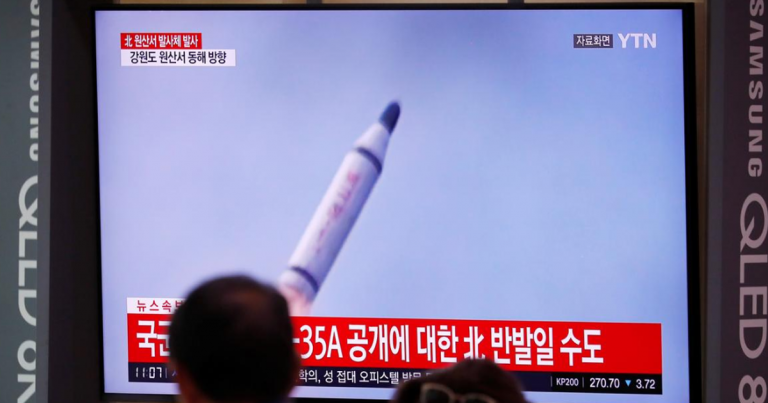
(Reuters) – North Korea fired a missile off its east coast on Wednesday that South Korea said may have been launched from a submarine, a day after it announced the resumption of talks with the United States aimed at ending its nuclear program.
The launch was likely a reminder by the North of its weapons capability ahead of the talks with Washington, analysts said. North Korea rejects United Nations resolutions that ban Pyongyang from using ballistic missile technology, saying they are an infringement of its right to self-defense.
Talks aimed at dismantling North Korea’s nuclear and missile program have been stalled since a second summit between U.S. President Donald Trump and North Korean leader Kim Jong Un in Vietnam in February ended without a deal.
South Korea’s military said it had detected the launch of one missile that flew 450 km (280 miles) and reached an altitude of 910 km (565 miles). It was likely a Pukguksong-class weapon, as the North’s earlier submarine-launched ballistic missiles (SLBMs) were known, that is under development.
South Korean Defense Minister Jeong Kyeong-doo told a parliamentary committee on Wednesday that the Pukguksong has a range of about 1,300 km (910 miles) and that the apogee of the missile fired on Wednesday may have been raised to reduce the distance it traveled.
South Korea’s military said the missile was launched eastward from the sea northeast of Wonsan, the site of one of North Korea’s military bases on the east coast.
Japanese Prime Minister Shinzo Abe condemned the launch, saying it was a violation of U.N. Security Council resolutions.
The National Security Council in Seoul expressed “strong concern” over the launch of what it said may have been an SLBM that came just a day after the announcement of working-level nuclear talks, according to a statement issued by the presidential Blue House.
Japan’s chief Cabinet secretary Yoshihide Suga said it appeared that one missile was launched and had split in two and then fallen into the sea. The Japanese government had said earlier it appeared North Korea had launched two missiles, one of which fell inside Japan’s Exclusive Economic Zone (EEZ).
South Korea’s Jeong, asked about Japan’s earlier assessment of two missiles, said the missile might have had at least two stages that separated in flight.
North Korea had been developing SLBM technology before it suspended long-range missile and nuclear tests and began talks with the United States that led to the first summit between Kim and Trump in Singapore in June 2018.
State news agency KCNA released photos and a story of leader Kim Jong Un in July inspecting a large, newly built submarine, seen as a potential signal that Pyongyang was continuing with its development of an SLBM program.
MONTHS OF STALEMATE
A senior U.S. administration official, who spoke on condition of anonymity, said: “We are aware of reports of a possible North Korean missile launch. We are continuing to monitor the situation and consulting closely with our allies in the region.”
The latest launch was the ninth since Trump and Kim met at the Demilitarized Zone border between the two Koreas in June and pledged to reopen working-level talks within weeks.
Hours before Wednesday’s launch, North Korean Vice Foreign Minister Choe Son Hui said in a statement the talks would be held on Saturday in a development that could potentially break what had been months of stalemate.
North Korea’s previous missile launch was on Sept. 10, also hours after Choe had expressed Pyongyang’s willingness for talks with the United States.
Leif-Eric Easley, a professor at Ewha University in Seoul, said: “While pursuing diplomacy, it is necessary to remain clear-eyed about North Korea’s continued provocations and lack of denuclearization.”
“North Korea tends to raise the stakes before negotiations in an effort to win unearned concessions,” he said.
Trump has played down North Korea’s recent series of short-range launches, saying in September the United States and North Korea “didn’t have an agreement on short-range missiles” and that many countries test such weapons.
North Korea continued its rhetoric against South Korea in a commentary in its official newspaper on Wednesday, criticizing its joint military drills with the United States as “unchangingly aggressive”.
“The root cause of the stalemate in the North-South relations lies, in short, in the South Korean authorities’ treacherous behavior,” the Rodong Sinmun commentary said.
North Korea’s latest missile launch showed the need for close cooperation between Japan and South Korea, said Narushige Michishita, a vice president of the National Graduate Institute for Policy Studies in Tokyo and a former Japanese defense official.
Seoul’s decision not to renew an intelligence-sharing pact with Japan was “really unfortunate”, Michishita said. South Korea decided in August to terminate the pact after Japan tightened curbs on exports of high-tech materials vital to South Korea’s chip and display industries as part of a long-running dispute over forced wartime labor.
“Primarily, South Korea is under the greatest threat. The U.S.-Japan alliance is there to defend Japan but a lot is about the defense of South Korea, and South Korea is undermining the defense mechanism designed to defend them,” Michishita said.





